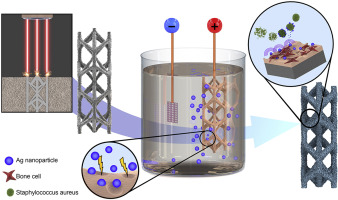[해외]네덜란드 연구원, 새로운 유형의 항균성 뼈 임플란트 3D 인쇄 성공
- 2020-07-14
- 관리자
○ 본문요약 :
델프트 대학은 연구원으로부터 설계 및 항균 특성을 가진 다공성 티타늄 뼈 이식을 인쇄했다.
이 팀은 플라즈마 전해 산화라는 새로운 생체 기능화 방법을 활용하여 스트론튬과은 나노 입자를 임플란트에 장착하여 24시간 이내에 악명 높은 내성 포도상 구균 박테리아를 제거 할 수 있었습니다.
연구원들은 스트론튬과은 사이에서 발견 된 상승적 항균 작용이 새로운 유형의 임플란트를 일으킬 수 있다고 믿고 있습니다.
Researchers from the Delft University of Technology have designed and printed a porous titanium bone implant with antibacterial properties.
Leveraging a novel biofunctionalization method called plasma electrolytic oxidation, the team was able to load the implant with strontium and silver nanoparticles, eradicating the notoriously resistant Staphylococcus aureus bacteria within 24 hours. The researchers believe the synergistic antibacterial behavior they discovered between the strontium and silver could give rise to a new type of implant – one that outlives patients with minimal maintenance.

임플란트 3D 프린팅 및 생체 기능화. 델프트 공과 대학교를 통한 이미지.
뼈 임플란트의 궁극적 인 목표는 환자가 임플란트보다 먼저 갈 때까지 느슨해지지 않도록하는 것입니다 (물론 그 목적을 수행하는 동안). 이를 위해서는 임플란트가 기본 뼈 조직을 대체해야하므로 주변 뼈가 임플란트 표면에서 자라서 골 형성 이라고하는 과정에서 융합됩니다 . 수년간 연구자들은 새로운 생체 재료의 합성, 표면 생체 기능화, 심지어 국소 활성제 전달을 포함한 여러 가지 접근법을 시도해 왔지만 여전히 시행 착오의 주제로 남아 있습니다.
The ultimate goal of a bone implant is to ward off loosening long enough that the patient goes before the implant does (all while serving its purpose, of course). To do this, the implant must replace the native bone tissue, whereby the surrounding bone grows over the surface of the implant and fuses to it in a process called osteogenesis. For years, researchers have tried a number of approaches, including the synthesis of new biomaterials, surface biofunctionalization, and even local active agent delivery, but it remains a topic of ongoing trial and error.

Ti64 임플란트의 다공성 구조. 델프트 공과 대학교를 통한 이미지.
○ 출처 : 
















